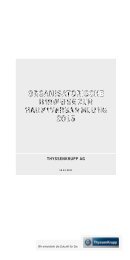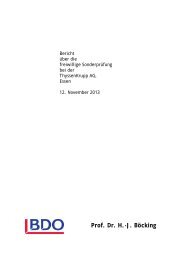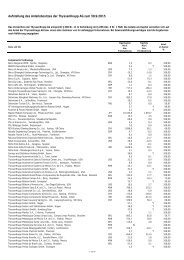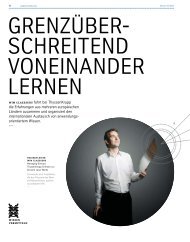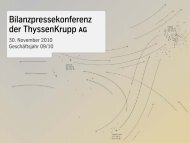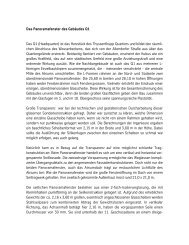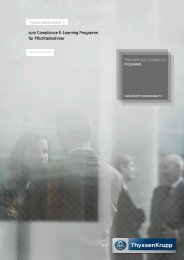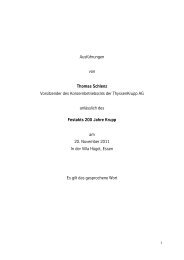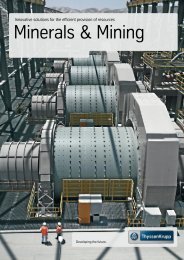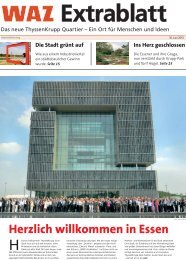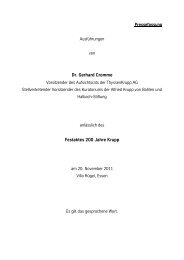PDF (10.9MB) - ThyssenKrupp AG
PDF (10.9MB) - ThyssenKrupp AG
PDF (10.9MB) - ThyssenKrupp AG
Create successful ePaper yourself
Turn your PDF publications into a flip-book with our unique Google optimized e-Paper software.
3.6 Consolidated financial statements Notes to the consolidated financial statements<br />
3.6 Consolidated financial statements Notes to the consolidated financial statements<br />
The new and amended standards are applicable for fiscal years<br />
beginning on or after January 01, 2013. Earlier application is<br />
permitted, but as well as disclosing the fact it has adopted early, an<br />
entity must early-adopt each of IFRS 10, IFRS 11, IFRS 12, IAS 27<br />
(2011) and IAS 28 (2011) at the same time. An exception to this<br />
requirement exists for IFRS 12; its disclosure requirements may be<br />
early-adopted either in full or in part. Currently, Management is not<br />
able to finally assess the impacts of the adoption of IFRS 10, 11 and<br />
12 – if endorsed by the EU in the current version.<br />
In May 2011 the IASB issued the new standard IFRS 13 “Fair Value<br />
Measurement”. IFRS 13 contains a definition of fair value and rules on<br />
how to determine it if other IFRS standards require fair value<br />
measurement; the standard itself does not prescribe in which cases<br />
fair value is to be used. With the exception of the standards explicitly<br />
excluded in IFRS 13, IFRS 13 defines standard disclosure requirements<br />
for all assets and liabilities that are measured at fair value and for all<br />
assets and liabilities for which disclosure of fair value in the notes to<br />
the consolidated financial statements is required; in particular it widens<br />
the disclosure requirements for non-financial assets. The new standard<br />
is compulsory for fiscal years beginning on or after January 01, 2013<br />
and shall be applied prospectively; earlier application is permitted. In<br />
the first year of application comparative information is not required.<br />
Currently, Management expects that the adoption of the new standard<br />
– if endorsed by the EU in the current version – will result in additional<br />
disclosures.<br />
In June 2011 the IASB issued amendments to IAS 1 “Presentation of<br />
Financial Statements” under the title “Presentation of Items of Other<br />
Comprehensive Income”. The amendments require a classification of<br />
items presented in other comprehensive income into items that might<br />
subsequently be reclassified to the income statement and items that<br />
will not. The amendments to IAS 1 are compulsory for fiscal years<br />
beginning on or after July 01, 2012; earlier application is permitted.<br />
Currently, Management does not expect the adoption of the<br />
amendments – if endorsed by the EU in the current version – to have a<br />
material impact on the Group’s consolidated financial statements.<br />
In June 2011 the IASB issued amendments to IAS 19 “Employee<br />
Benefits”. The amendments mainly concern the elimination of deferred<br />
recognition of actuarial gains and losses (corridor method) in favour of<br />
immediate recognition in other comprehensive income in equity, the<br />
presentation of changes to net liabilities/assets under defined benefit<br />
pension plans, and the recognition of a net interest expense or income<br />
resulting from net liabilities or assets of a pension plan. Furthermore<br />
additional disclosure regarding the characteristics of pension plans and<br />
the associated risks for the entity is required. The amendments to IAS<br />
19 are compulsory for fiscal years beginning on or after January 01,<br />
2013; earlier application is permitted. Currently, Management is not<br />
able to finally assess the impacts of the adoption of the amendments<br />
to IAS 19 – if endorsed by the EU in the current version. The adoption<br />
of the amended standard will result in additional disclosures.<br />
In October 2011 the IASB issued the IFRIC interpretion 20 “Stripping<br />
Costs in the Production Phase of a Surface Mine”. The interpretation<br />
regulates the accounting for stripping costs in the production phase of<br />
a surface mine. The interpretation clarifies under which conditions an<br />
asset must be recognized for the relating stripping measures and how<br />
initial and subsequent measurement of this asset has to be<br />
determined. The interpretation is compulsory for fiscal years beginning<br />
on or after January 01, 2013; earlier application is permitted.<br />
Currently, Management does not expect the adoption of the<br />
interpretation – if endorsed by the EU in the current version – to have<br />
an impact on the Group’s consolidated financial statements.<br />
146



